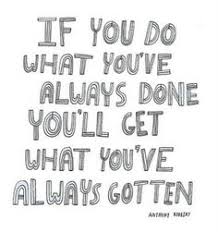NEW YEAR NEW RESOLUTION IS NOT ENOUGH, HERE ARE 5 GOAL SETTING TIPS THAT REALLY WORK.
Statistics tell us that as many as 62 percent of us make New Year’s resolutions — but only 8 percent will actually be successful in achieving their goals.
Why is that? Why is it so easy to say we will make a change, but then fail to follow through? Are we lazy? Lack of willpower?
I think it’s much less to do with laziness or willpower and more to do with the type of goals people set. Too often, a resolution is simply a vague statement of something we want to do. “I’m going to lose weight this year,” or “I’m going to get my credit card debt under control.”
But those sorts of goals are both hard to achieve and hard to measure. For example, if your resolution is to lose weight this year, do you succeed if you’re even a pound lighter by the end of the year? Most people would say no, because they wanted to lose more than just a pound — but they didn’t specify. In fact, even if you specify, “I’m going to lose 20 pounds this year,” most people will fail because they don’t make a plan for how to get there.
The answer, then, isn’t necessarily about having more willpower, but about setting better goals to start with. Setting goals the right way provides you with a framework to help you follow through — and that makes willpower much less necessary.
Five steps to achievable goals
The best framework I’ve found for personal goals is the same one I use with business clients: SMART goals. SMART stands for specific, measurable, achievable, relevant, and time-bound, and you must work through each step to define goals that you will actually be able to achieve.
1. Specific — As I mentioned above, you have to get specific about exactly what you hope to achieve; otherwise, how will you judge your progress? Try answering the five Ws when setting your goal:
→ What do you want to accomplish?
→ Why is it important to you?
→ When will you finish?
→ Who else is involved
→ Where will you get the resources or perform the tasks?
The more specific you get, the easier it will be to measure your progress and see whether or not you’re on track.
2. Measurable — Your goal must be measurable for the same reasons. If, for example, your resolution was to “get healthy this year,” that’s so vague as to be almost meaningless. Instead, you want to choose a goal that’s measurable. For example, you might say you want to lower your cholesterol by a certain number of points, run a mile in a certain time, or lift a certain amount of weight. This part of the goal answers how much or how many, and gives you a way to track your progress. Think of this as the KPIs (key performance indicators) for your goal.
Try to find ways to measure goals that don’t seem measurable. For example, if your goal is to get a promotion, you might decide that means you need to take a course to improve your skills or network with a certain number of people, both of which can be measured (even though your odds of getting the promotion are much more nebulous and difficult to measure).
3. Achievable — Your goal must be achievable if you want to avoid frustration and failure! Do some research to ensure that what you want to achieve is actually achievable. For example, most experts suggest that 0.5–2 pounds per week is healthy, sustainable weight loss, so it would be an achievable goal to lose 50 pounds in a year — but not to lose 50 pounds in a month.
Be sure to take into consideration outside factors like financial considerations when deciding if your goal is realistic and achievable. For example, if you’re looking to reduce debt, you might decide that you can forgo eating out and put that money towards debt reduction, but is that realistic? It might be more realistic to say that you will spend only $50 a month on eating out and put the other $50 towards debt reduction.
In addition, beware of setting goals that rely on someone else to make them happen. For example, if your goal is to get a promotion that relies on a lot of outside factors that you have no control over (who else applies, the hiring manager’s decision, etc.). But, a goal like “improve my skills to be considered for the promotion” is a goal you can definitely achieve on your own.
4. Relevant — One of the best tips I ever heard was that when you’re saying to yourself, “I should do this or that,” the “should” is someone else talking. The question of relevance is about asking yourself if you actually want to achieve the goal and if it aligns with your other goals.
For example, you may think that you ought to lose weight or go for that promotion, but it is that because it’s what you want or because what others (friends, family, society) want for you?
Maybe you want to get a promotion, but it’s not a good time to commit to additional training, or you don’t have the money to invest right now, or you want to start a family and may not have time for the additional workload.
5. Time-Bound — A time-bound goal means you know when you’re going to achieve your goal and each sub-goal along the way.
Ask yourself:
→ When will I achieve the goal?
→ What will I have achieved 6 months from now?
→ What will I have achieved 1 month from now?
→ What can I achieve today?
This helps you break down your goal into smaller, more manageable steps. It’s hard to lose 20 pounds; but it’s easy to choose fruit for breakfast and take a 10 minute walk today.
If you take the time to answer each of these questions to create a framework for your goal, you’ll be much more likely to succeed.
For long-term goals, you might add two more steps to the framework: Evaluate and Review. This means that you evaluate your progress at regular intervals, and schedule time to review what worked and what didn’t within that time period.
With this framework, you’re well on your way to making it into the 8 percent of people who succeed at their New Year’s resolutions.
Thanks for your audience
Reference: Bernard MarrStatistics tell us that as many as 62 percent of us make New Year’s resolutions — but only 8 percent will actually be successful in achieving their goals.
Why is that? Why is it so easy to say we will make a change, but then fail to follow through? Are we lazy? Lack of willpower?
I think it’s much less to do with laziness or willpower and more to do with the type of goals people set. Too often, a resolution is simply a vague statement of something we want to do. “I’m going to lose weight this year,” or “I’m going to get my credit card debt under control.”
But those sorts of goals are both hard to achieve and hard to measure. For example, if your resolution is to lose weight this year, do you succeed if you’re even a pound lighter by the end of the year? Most people would say no, because they wanted to lose more than just a pound — but they didn’t specify. In fact, even if you specify, “I’m going to lose 20 pounds this year,” most people will fail because they don’t make a plan for how to get there.
The answer, then, isn’t necessarily about having more willpower, but about setting better goals to start with. Setting goals the right way provides you with a framework to help you follow through — and that makes willpower much less necessary.
Five steps to achievable goals
The best framework I’ve found for personal goals is the same one I use with business clients: SMART goals. SMART stands for specific, measurable, achievable, relevant, and time-bound, and you must work through each step to define goals that you will actually be able to achieve.
1. Specific — As I mentioned above, you have to get specific about exactly what you hope to achieve; otherwise, how will you judge your progress? Try answering the five Ws when setting your goal:
→ What do you want to accomplish?
→ Why is it important to you?
→ When will you finish?
→ Who else is involved
→ Where will you get the resources or perform the tasks?
The more specific you get, the easier it will be to measure your progress and see whether or not you’re on track.
2. Measurable — Your goal must be measurable for the same reasons. If, for example, your resolution was to “get healthy this year,” that’s so vague as to be almost meaningless. Instead, you want to choose a goal that’s measurable. For example, you might say you want to lower your cholesterol by a certain number of points, run a mile in a certain time, or lift a certain amount of weight. This part of the goal answers how much or how many, and gives you a way to track your progress. Think of this as the KPIs (key performance indicators) for your goal.
Try to find ways to measure goals that don’t seem measurable. For example, if your goal is to get a promotion, you might decide that means you need to take a course to improve your skills or network with a certain number of people, both of which can be measured (even though your odds of getting the promotion are much more nebulous and difficult to measure).
3. Achievable — Your goal must be achievable if you want to avoid frustration and failure! Do some research to ensure that what you want to achieve is actually achievable. For example, most experts suggest that 0.5–2 pounds per week is healthy, sustainable weight loss, so it would be an achievable goal to lose 50 pounds in a year — but not to lose 50 pounds in a month.
Be sure to take into consideration outside factors like financial considerations when deciding if your goal is realistic and achievable. For example, if you’re looking to reduce debt, you might decide that you can forgo eating out and put that money towards debt reduction, but is that realistic? It might be more realistic to say that you will spend only $50 a month on eating out and put the other $50 towards debt reduction.
In addition, beware of setting goals that rely on someone else to make them happen. For example, if your goal is to get a promotion that relies on a lot of outside factors that you have no control over (who else applies, the hiring manager’s decision, etc.). But, a goal like “improve my skills to be considered for the promotion” is a goal you can definitely achieve on your own.
4. Relevant — One of the best tips I ever heard was that when you’re saying to yourself, “I should do this or that,” the “should” is someone else talking. The question of relevance is about asking yourself if you actually want to achieve the goal and if it aligns with your other goals.
For example, you may think that you ought to lose weight or go for that promotion, but it is that because it’s what you want or because what others (friends, family, society) want for you?
Maybe you want to get a promotion, but it’s not a good time to commit to additional training, or you don’t have the money to invest right now, or you want to start a family and may not have time for the additional workload.
5. Time-Bound — A time-bound goal means you know when you’re going to achieve your goal and each sub-goal along the way.
Ask yourself:
→ When will I achieve the goal?
→ What will I have achieved 6 months from now?
→ What will I have achieved 1 month from now?
→ What can I achieve today?
This helps you break down your goal into smaller, more manageable steps. It’s hard to lose 20 pounds; but it’s easy to choose fruit for breakfast and take a 10 minute walk today.
If you take the time to answer each of these questions to create a framework for your goal, you’ll be much more likely to succeed.
For long-term goals, you might add two more steps to the framework: Evaluate and Review. This means that you evaluate your progress at regular intervals, and schedule time to review what worked and what didn’t within that time period.
With this framework, you’re well on your way to making it into the 8 percent of people who succeed at their New Year’s resolutions.
Thanks for your audience
By Adegbosin Amos
Reference: Bernard Marr











Comments
Post a Comment